Looking to learn about the wonderfully weird pacu fish? You’re in the right place! In this post, we’ll tell you all about this weird fish and tell you the truth from fact and fiction.
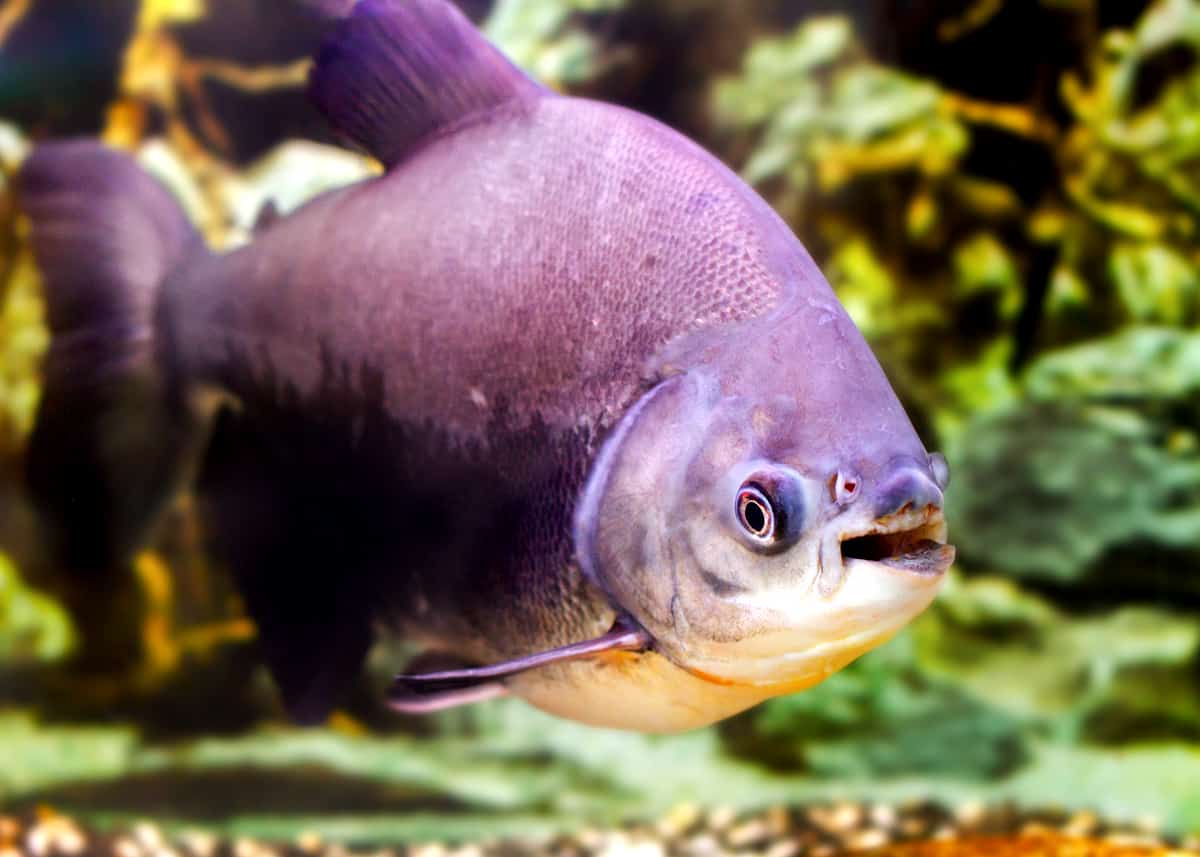
Table of Contents
38 Pacu Fish Facts
Despite being known as the “vegetarian piranha,” pacu fish don’t have much in common with their fearsome cousins.
They’d rather munch on a banana than a human, and they’re pretty laid-back in terms of temperament. Some have even been known to nuzzle against their owner like a dog!
Are you interested in buying a pacu fish? Or maybe you’d like to learn more about these fascinating creatures from South America. Here are some pacu fish facts for you!
1. What does the pacu fish look like?
Pacu fish have broad, flat bodies with fins on their backs and bellies. They can grow several feet long and weigh a hefty handful.
Pacu fish usually come in solid neutral colors like silver, gray, black and white, but there are a few breeds with flashier hues, including the red-bellied pacu (Piaractus brachypomus).
They can also have markings like the black-ear pacu (Myloplus schomburgkii).
Some species of pacu fish have distinctive characteristics like the downward-facing “beaks” found in parrot pacu (Ossubtus xinguense).
One common feature of all breeds of pacu fish is their human-like teeth. Unlike some fish species that have sharp, jagged fangs meant for slicing through their prey, pacu fish have two sets of blunt molars that they use for cracking nuts and grinding up plants.
This means that when you peel back the “lips” of a pacu fish, you’ll see a mouth that looks and functions quite like yours.
2. What kind of fish has human-like teeth?
The pacu fish isn’t the only animal under the sea with a good set of choppers. There’s at least one other species like them: the sheepshead fish.
These fish have large front teeth to help them crush through the shells of crustaceans, and they’re also notorious for biting the bait off fishermen’s’ hooks.
3. How big is a pacu fish?
Depending on the species, the pacu fish can measure anywhere from 7 – 42 inches long.
One of the smallest breeds, the silver mylossoma (Mylossoma duriventre), maxes out at 10 inches long.
One of the largest breeds, the black pacu (Colossoma macropomum), measures up to 40 inches long.
4. How much does a pacu fish weigh?
The pacu fish can weigh anywhere from 2 – 97 pounds depending on its breed.
5. What’s the world record for the biggest pacu fish?
The largest catch officially recognized by the International Game Fish Association (IGFA) was 71 pounds.
Since we know that pacu fish can get even bigger, however, it’s only a matter of time before another fisherman breaks the record.
6. How many pacu fish species are there?
There are many different species of pacu fish. In fact, “pacu fish” is more of an umbrella term than a specific breed. They can differ in size, color, diet, and habitat while still being considered pacus.
Here are a few common pacu fish and the things that make them memorable:
- The black pacu (Colossoma macropomum) is also known as the giant pacu. Measuring up to 3.5 feet long and weighing up to 97 pounds, it’s the largest species of pacu.
- The parrot pacu (Ossubtus xinguense) has a mouth that slopes downwards with age and gives it a beak-like appearance. It’s also known as the eagle-beak pacu.
- The red-bellied pacu (Piaractus brachypomus) has a gray body with a red or orange patch on its belly. This is a form of mimicry that protects it from predators since the red-bellied piranha has very similar coloring. Predators will leave the pacu alone because they think that it’s a piranha!
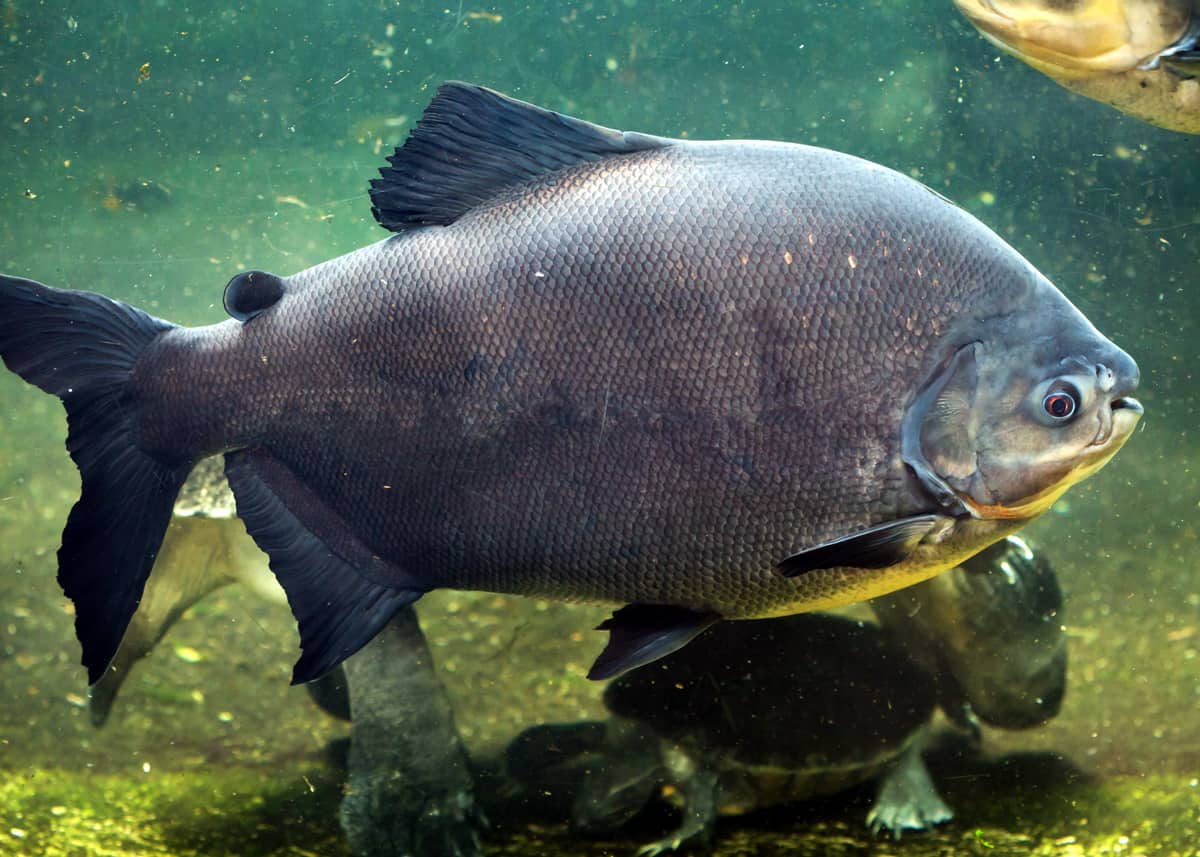
7. How did the pacu fish get its name?
Pacu is an old word from the Tupi-Guarani languages of South America. It means “quick eater” and refers to the way that pacu snap up things like nuts and algae.
8. What is the pacu fish Latin name?
There’s not a single scientific name for pacu fish. Its species are scattered across several different genus groups. Here’s a breakdown of their family tree:
- Class: Actinopterygii (ray-finned fish)
- Order: Characiformes (specific types of ray-finned fish)
- Family: Serrasalmidae (the “serrated salmon family” that includes piranhas, silver dollars and pacu fish)
From there, pacu fish can be classified into various genus groups:
- Colossoma: Colossoma macropomum (black pacu)
- Piaractus: Piaractus brachypomus (red-bellied pacu), Piaractus mesopotamicus (small-scaled pacu)
- Ossubtus: Ossubtus xinguense (parrot pacu)
9. What other names does the pacu fish have?
The pacu fish has many names. Some of them are obvious: The red-bellied pacu (Piaractus brachypomus) has red scales on its bottom half, and the black-ear or black-band pacu (Myloplus schomburgkii) has two black stripes on its body.
Other names have more of a story behind them. For example, the red-bellied pacu has also been nicknamed the “ball-cutter pacu” because of mostly-exaggerated rumors that it will go after a man’s testicles in the water.
(We’ll cover the show from Schmational Schmigrafic in point #36…😏)
Additionally, there are species of pacu fish that have attracted different names in their home countries.
The small-scaled pacu (Piaractus mesopotamicus) is also known as pez chato or “flat fish” because of its resemblance to a flattened pancake.
The black pacu (Colossoma macropomum) is also called the tambaqui.
10. How can you tell the difference between a piranha and a pacu?
With their flat, light-colored bodies, pacus and piranhas are often mistaken for each other at first glance.
When you look a little closer, however, you’ll be able to spot the differences:
- Teeth. Piranhas have sharp, jagged teeth that are meant for cutting. Pacu fish have flat, blunt teeth that are used for grinding.
- Size. Piranhas are usually 1 – 2 feet long. By contrast, the largest species of pacu fish can grow to 3.5 feet long.
- Color. The red-bellied pacu looks a lot like the red-bellied piranha, and this isn’t a coincidence. It’s a natural form of mimicry that protects young pacu from predators. However, the red color fades by adulthood because they grow so large that they don’t need to scare off predators anymore. If you see a fish with fading red scales, it’s a pacu and not a piranha.
11. Can you eat pacu fish?
Yes. In fact, pacu fish are known for being delicious! They’re commonly sold in South American restaurants with side dishes of rice, lettuce, onions, and plantains.
Frying is the most common method of preparation, but they’re also baked, grilled, broiled, steamed and poached.
12. What does pacu fish taste like?
Pacu fish are said to have a mild, almost sweet flavor that’s similar to tilapia and trout.
Theodore Roosevelt praised their taste when he wrote about catching and eating them in his book Through the Brazilian Wilderness.
13. Are pacu fish aggressive?
Not normally. Despite the fact that they can grow to the size of a small child, pacu fish aren’t known as an aggressive species.
They feed primarily on nuts and plants, so they aren’t big predators, and they don’t have dominant or territorial instincts.
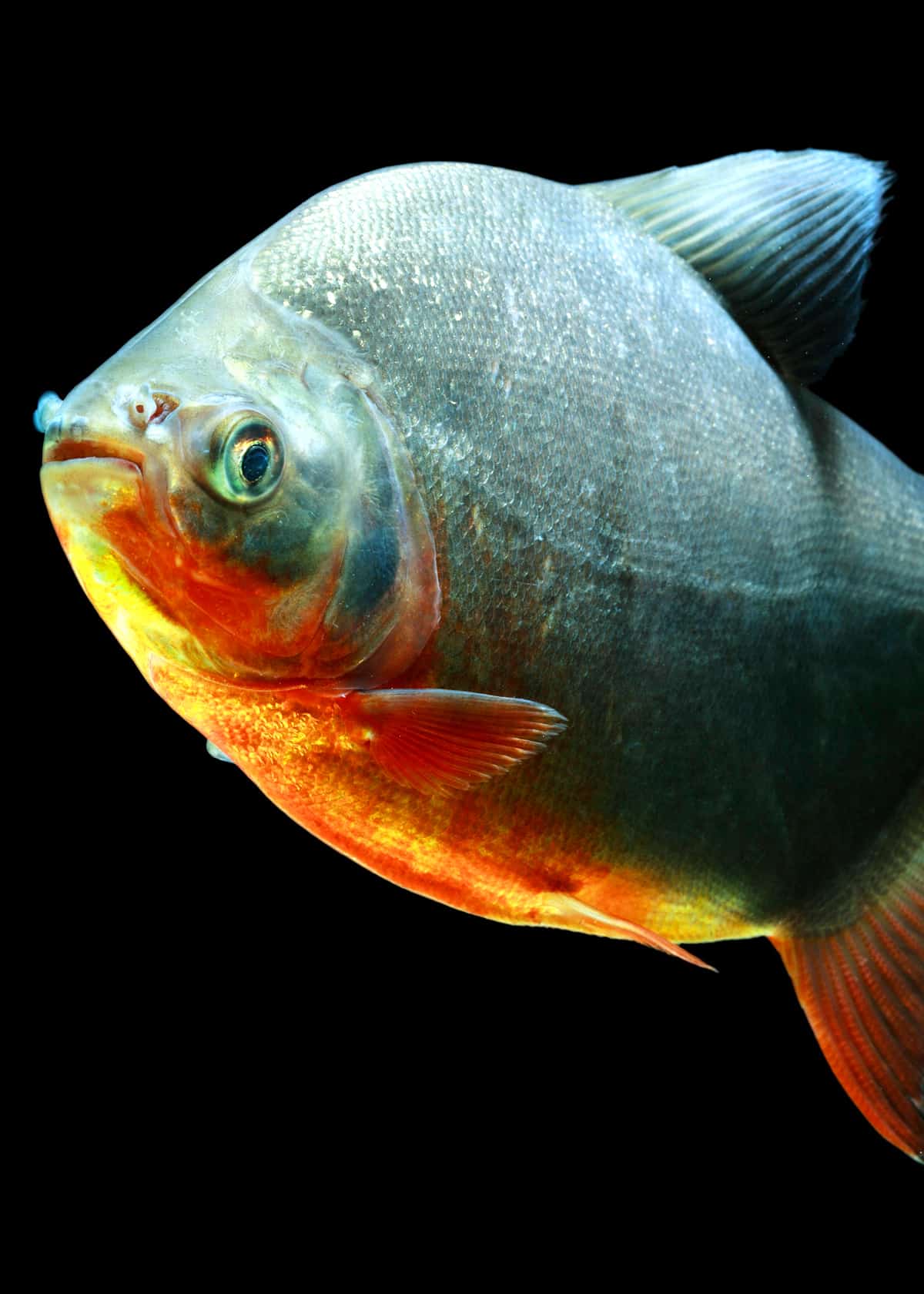
This isn’t to say that pacu fish can’t be aggressive. They’ll feed on smaller fish when the opportunity presents itself, and they’re actually considered an invasive species in many parts of the world because of the quick, efficient way that they can take over ecosystems.
Pacu fish aren’t piranhas, but they aren’t goldfish, either.
14. Do pacu fish have teeth?
Yes. Pacu fish have two rows of blunt, human-like teeth. They’re capable of biting and grinding but not chewing.
15. Why do pacu fish have human-like teeth?
Without their unique teeth, pacu fish wouldn’t be able to consume the nuts, seeds, and fruits that they love so much. The nuts would be particularly difficult.
Not only would pacus struggle to crack them open, but they’d lack the ability to grind them into something soft and palatable for swallowing.
16. Do pacu fish bite?
Yes. Pacu fish have a strong set of teeth that can crack open all sorts of nuts and food pellets. They’ve also been known to bite humans when they mistake someone for food.
For example, a toddler was bitten by a pacu fish at an aquarium in Scotland, but officials say that it wasn’t a sign of aggression. The fish just saw her wiggling fingers as bait.
Pacu fish have also made headlines for biting at the nether regions of men, but this is mostly an exaggeration. There’s only been one confirmed report of a man receiving a pacu bite. Most of the pacu fish’s reputation as a “ball-cutter” comes from sensational media reports.
17. How long do pacu fish live?
Pacu fish generally live around 15 – 25 years, but they’ve been known to top 30 years in captivity.
The world record for the oldest pacu was held by a 43-year-old black pacu.
18. What eats a pacu fish?
Larger pacu species tend to be left alone by predators because of their size. Smaller species, however, are vulnerable to everything from birds to crocodiles.
Juveniles are also vulnerable in ways that adults aren’t. Young pacu fish are only a few inches long when they’re born, and it might take them several years to become a two- or three-footer, so they need to avoid reptiles, birds, crocodiles, and bigger fish until they mature.
19. Can pacu fish survive anything?
Pacu fish have gotten a steely reputation over the years, but it’s not quite accurate. They aren’t unkillable.
They’re just highly adaptable, so they can detect unfavorable conditions in their environment and adjust their behavior accordingly.
For example, pacu fish are very sensitive to disturbances in the water. They can hear high-pitched sounds that other fish are deaf to, so if predators are coming, they’ll know before anyone else.
They can also adapt to things like low oxygen levels or poor nutrient levels in their water. When these things are detected, they’ll make changes to their movements and behaviors in hopes of riding out the problem. If the problem persists, they’ll migrate to a new place.
20. Do pacu fish stop growing in small tanks?
No. It’s a common misconception that pacu fish will “fit their tanks” by growing or not growing in tandem with their tank size.

The truth is that pacu fish grow at steady rates regardless of where they’re housed; this is why hobbyists are encouraged to buy large tanks for pacu fish even when they’re young, squiggly juveniles.
They’ll get a lot bigger over the years.
21. Is the pacu fish endangered?
Pacu fish haven’t been evaluated by conservation groups, so it’s difficult to know if they’re endangered. There are a few conflicting schools of thought on the topic.
On one hand, there are dozens of pacu fish breeds, and they occupy wide and diverse habitats throughout South America. They’re also sold as pets worldwide. This would suggest that they aren’t going anywhere.
On the other hand, there are a number of issues that could affect the native populations of pacu fish:
- Fishing demands. Commercial fishing increases in the Amazon each year, and experts have warned that its growing demand could have a negative impact on all kinds of wildlife.
- Pollution. Studies have shown that pacu fish have a low tolerance for pesticides, and they’re frequently used in South America on banana and cacao crops. These chemicals can both kill pacu fish and cause health issues that prevent them from reproducing.
- Dams and other man-made structures. This is a particular concern with species like the parrot pacu (Ossubtus xinguense). It’s found exclusively in the Xingu River of Brazil, and the construction of a hydroelectric dam recently made headlines for disturbing the flow of the river and all of its occupants.
Some experts are suggesting that species like the parrot pacu could already be endangered. We won’t know for sure until a group like the International Union for the Conservation of Nature (IUCN) evaluates them.
22. Is the pacu fish considered an invasive species?
Yes. Pacu fish are large fish that consume a lot of natural resources, so they have a tendency to overrun the habitats that they occupy.
This becomes a problem when they outgrow the aquariums of their owners and are released into the wild. The owners think that they’re being humane, but they’re actually introducing an invasive species to a new ecosystem!
One Texas town was so frustrated by their pacu problem that they started to offer a $100 bounty on them to eliminate them from a local lake.
23. Can pacu live without oxygen?
No. Pacu fish can’t live without oxygen, but they can survive low oxygenation levels thanks to their natural adaptive abilities.
For example, if they find themselves in low-oxygen water, they’ll start protruding their lower lip to increase their respiration and get more oxygen into their system.
24. Can pacu fish communicate with each other?
Yes. They don’t make noise, but pacu fish can leave chemical signals for one another. The most obvious example is when they’re injured.
Pacu fish can secrete an “alarm chemical” from their wound that lets everyone else know about nearby danger.
25. Do pacu fish eat meat?
Yes. While pacu fish show a preference for plant life, they aren’t afraid to chomp down on insects or smaller fish, especially when resources are scarce. They’re survivors before anything else.
26. What do pacu fish eat?
In the wild, pacu fish consume things like nuts, fruits, and seeds. They’ll wait for their food to drop from tree branches or swell into their water from a nearby flood or marsh.
As previously mentioned, they’ll munch on smaller fish when food is scarce, but they’re more herbivores than carnivores.
Pacu fish in captivity are generally fed a diet of fish pellets supplemented by fresh fruits and veggies. Pacu fish will eat spinach, lettuce, apples, bananas, peas, grapes and carrots. Their human-like teeth allow them to grind up the same foods that people eat.
Pacu fish can be fed meat in captivity, but anecdotal evidence suggests that giving them too many worms or shrimp can turn them into picky eaters. The consensus is that it’s like giving a child too much junk food.
27. What kind of nuts do pacu fish eat?
Pacu fish like all kinds of nuts. They’ll gobble up walnuts, peanuts, almonds, and anything else that falls or floats into their water.
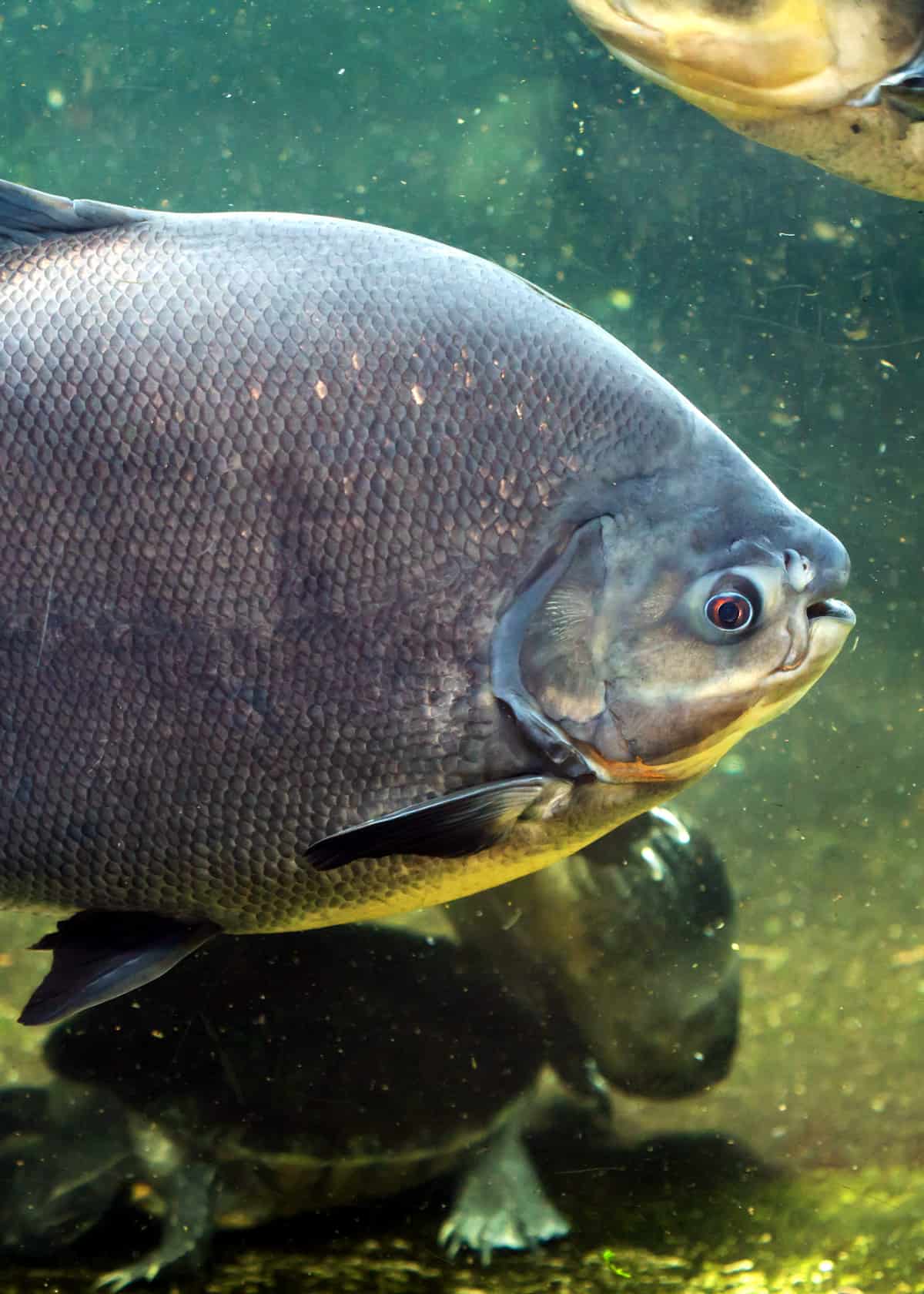
28. Do pacu fish carry disease?
You don’t have to worry about getting sick from your pacu platter. They don’t carry any diseases that can hurt humans.
That said, pacu fish can be hosts to worms and parasites, and this can impact their health if you’re keeping them as pets. If you notice your pacu fish acting strangely, you’ll want to get them to a specialist for evaluation.
29. Are pacu fish poisonous or venomous?
No. Pacu fish don’t have any poison or venom at all. They don’t have the glands to make it, and they don’t have the fangs to deliver it.
30. How do pacu fish reproduce?
Pacu fish reproduce by spawning.
Rather than mating in the traditional way, the female releases a large number of unfertilized eggs into the water, and the male releases sperm to fertilize them after the fact. This isn’t uncommon in aquatic species.
31. Do pacu fish lay eggs? How many?
Yes. Are you ready for this? Pacu fish usually release around 150,000 – 200,000 eggs at a time.
Some females can even release as many as one million eggs!
32. Do pacu fish protect their eggs?
No. Pacu fish don’t provide any care for their eggs. They just release them and go. When the eggs hatch, the juveniles are independent right away, so they don’t need mom or dad’s help to survive.
One species, the parrot pacu (Ossubtus xinguense), does make a cursory effort to give their eggs a fighting chance. The females have been observed entering a cave before they spawn.
This privacy helps to protect their offspring from roaming snakes and birds who like to snack on fish eggs like popcorn.
33. Where does the pacu fish live?
Pacu fish are native to South America. Their exact region depends on their breed:
- Parrot pacu (Ossubtus xinguense) are found in the Xingu River of Brazil.
- Small-scaled pacu (Piaractus mesopotamicus) are exclusive to the Paraguay-Parana River basin that flows through Paraguay, Brazil and Argentina. It’s sometimes called the Parana River pacu.
- Silver mylosommas (Mylossoma duriventre) are found in the Amazon and Orionco River basins. This puts them in Venezuela, Columbia, Brazil and Ecuador.
- Black pacu (Colossoma macropomum) are spread throughout Ecuador, Guyana, Bolivia, Brazil, Peru and Suriname.
34. Where are pacu fish sold as pets?
As pets, pacu fish have been shipped worldwide. They’ve also been released into the wild by hobbyists, so they’ve formed small populations everywhere from Asia to Australia.
Some species have even been deliberately introduced to lakes and rivers to increase fishing opportunities, but regions have come to regret this when the pacu fish takes over the ecosystem.
35. Can pacu live in cold water?
No. Pacu fish are native to the hot, humid climate of the Amazon, so they’re not used to the cold.
They can physically survive a temperature range from 59°F – 95°F, but they’ll stop eating when the water dips below 64°F.
36. Have pacu fish ever been featured in movies or documentaries?
Yes. The red-bellied pacu fish (Piaractus brachypomus) was featured on River Monsters, a documentary series about big and dangerous fish from around the world.
The host went to South America to investigate their reputation for biting male swimmers.
37. What is the habitat of the pacu fish?
All pacu fish live in water, but they can differ in the types of water that they like.
For example, the parrot pacu (Ossubtus xinguense) is found in fast-moving rapids while the black pacu (Colossoma macropomum) prefers calm waters in flooded river basins and wetlands.
38. Where can I see the pacu fish?
Pacu fish aren’t rare, so you can find them in all sorts of zoos, aquariums, pet shops, and wildlife exhibits.
You can even buy them online if you aren’t located near any living populations!
Pacu Fish as Pets
39. Can you have a pacu fish as a pet?
In terms of temperament, pacu fish make great pets. They’re calm, docile and willing to eat just about anything, so they won’t stress you out in terms of everyday care.
Their only real downside is their size.
40. Is it legal to own a pacu fish?
You’ll want to check your local laws before buying a pacu fish.
Some countries have restrictions on buying and selling them since they’re considered an invasive species.
In the U.S., these restrictions can vary by state, so call your area’s wildlife service and ask.
41. How do you take care of a pacu fish?
There are a few things to consider when caring for a pacu fish:
- Habitat. Pacu fish need a large tank or pond. Some people don’t realize this when they purchase pint-sized juveniles, so understand in advance that your pacu will grow, grow and grow some more.
- Diet. Pacu fish will eat a wide range of food, but you don’t want to overfeed them and risk an excessive amount of waste building up in their tanks. Keep the treats to a minimum. Don’t use them as garbage disposals.
- Lifespan. The oldest pacu fish in the world lived to be 43 years old. Are you ready to take care of a pacu for that long?
- Solitude. You should keep your pacu fish separated from other fish species. While they’re non-aggressive in a general sense, they’re still omnivores and opportunistic feeders.
Aside from these things, pacu fish shouldn’t give you a lot of trouble. You might not want to buy them as your first fish since they’re such a long-term commitment, but if you’ve successfully raised other marine animals, the pacu fish should be a piece of cake.
42. Can pacu fish show affection?
While you shouldn’t expect your pacu fish to be a cuddler, there’s evidence to suggest that they can learn to recognize and reciprocate human contact.
One pacu fish named Swish was a staple of a Chinatown restaurant in Washington for more than 30 years, and he’d let customers stick their hands in his tank and rub his body against them!
43. What size tank does a pacu need?
Pacu fish need large tanks. An adult can reach up to 3.5 feet long. It won’t fit into a goldfish bowl!
The recommended tank size for an adult pacu fish is 250 gallons or more.
44. Can you keep pacu fish in an outdoor pond?
If you’re unable or unwilling to buy a gigantic aquarium for your pacu fish, you can keep them in an outdoor pond.
They’ll clean their own water by eating all of the leaves and bugs that drop into it, and temperature shouldn’t be a problem as long as the weather never gets too cold.
Just make sure that your pond is contained. It shouldn’t feed into other water sources like rivers or streams. This could enable your pacu fish to swim to freedom and become a problem in the local ecosystem.
Also, keep in mind the temperature of the outdoor pond. We’ll talk about the necessary temperatures for pacus in #40.
45. What kinds of tanks are best for pacu fish?
The most important thing for a pacu tank is size. Aside from that, you’ll also want to provide plenty of decorations in the form of artificial plants and driftwoods.
Pacu fish can get anxious without places to hide.
Another consideration is buying a tank with a lid. Pacu fish have a habit of snatching their food as it floats through the water, and this can result in large waves and spills.
Smaller pacus might even launch themselves out of the tank accidentally.
46. Can pacu fish live with koi fish?
It isn’t recommended that you house your pacu with any other fish.
They tend to see smaller species as food, so even if they get along with the koi in the first few days of cohabitation, you might come home one day to an empty pond and a satisfied-looking pacu.
47. How much does a pacu fish normally cost?
Pacu fish are usually sold as small juveniles, so they aren’t expensive. You can find them starting at prices as low as $7.
48. Can pacu live with piranha?
This is a complex question. It isn’t impossible for pacus and piranhas to live in harmony; some hobbyists have done it.
However, it’s a delicate living situation, and it requires a gigantic tank and near-constant supervision to make sure that the creatures don’t turn on each other.
In the event of a fight, the piranha will probably win, so you could lose your pacu fish.
49. What temperature does a pacu fish need?
The ideal temperature range for pacu fish is 76°F – 82°F.
Some species can survive in colder water, but unless you’re an expert who understands the intricacies of different breeds, it’s best to stick to the recommended temperatures!
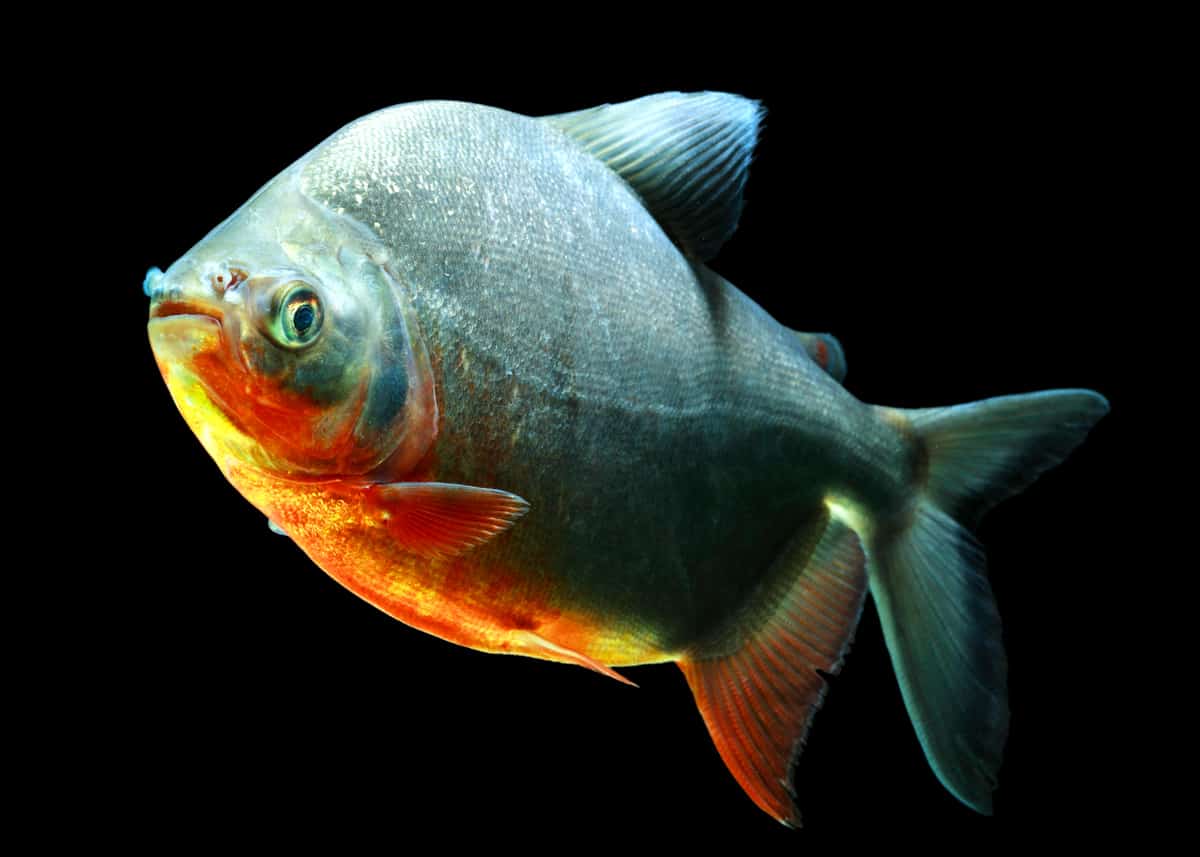
Peculiar Pacus
These are just a few things to know about pacu fish. As you can see, they’re a lot friendlier than their uncanny teeth might suggest, so they’re a great example of why you shouldn’t judge a book by its cover. They’re not as scary as you may think!
We hope that you’ve learned to love them a little more with the help of these pacu fish facts!
Have more questions? Leave them in the comments!
Drew Haines is an animal enthusiast and travel writer. She loves to share her passion through her writing.
She graduated high school at sixteen and started her own business, Everywhere Wild Media. And she runs Everywhere Wild and JustBirding. She also guest blogs on Storyteller.Travel
She lived in Ecuador for 6 years and explored the Galapagos Islands. Currently based in N.S., Canada.

Carol Disch
Sunday 1st of May 2022
I have a pacu, Bubba, he was 30 in April, 2022. He is in a 230 - ? Or close to it tank. Moved 3 times with him when he was smaller. Never been sick a day in his life. He used to like floating pellets but has now gone to sinking algae wafers - large ones, 30 every other day.
Paulin
Sunday 21st of February 2021
as any one raised a pacu fish.
KRose
Saturday 30th of July 2022
@Paulin, I have a very big Red Bellied Pacu. 7 years old and 20 inches long. He has out survived all his tank mates and lives alone now. My 130 gallon tank is looking too small!
Jason Weigner
Friday 23rd of October 2020
Thank you for this! I'm thinking of putting in a pond for Pacu in Bolivia. This was great for getting to know them a bit more!
Lisa
Wednesday 25th of December 2019
I had a red bellied pacu for years (Probably close to a decade). His name was Tubbatron and he was awesome! He would let you pet him, he liked to be hand fed cantaloupe, and he played tag with my cat!
Craig
Tuesday 8th of October 2019
I have own a very healthy pacu for 30+ years now it’s in a 300 gallon tank with two high-quality filters it’s very healthy because of its organic vegetable and fruit diet my wife and I are planning to go on vacation and we’re wondering if we feed the fish heavily before we go how long safely will it be able to fast? we can plan are time away around that thank you very much Craig